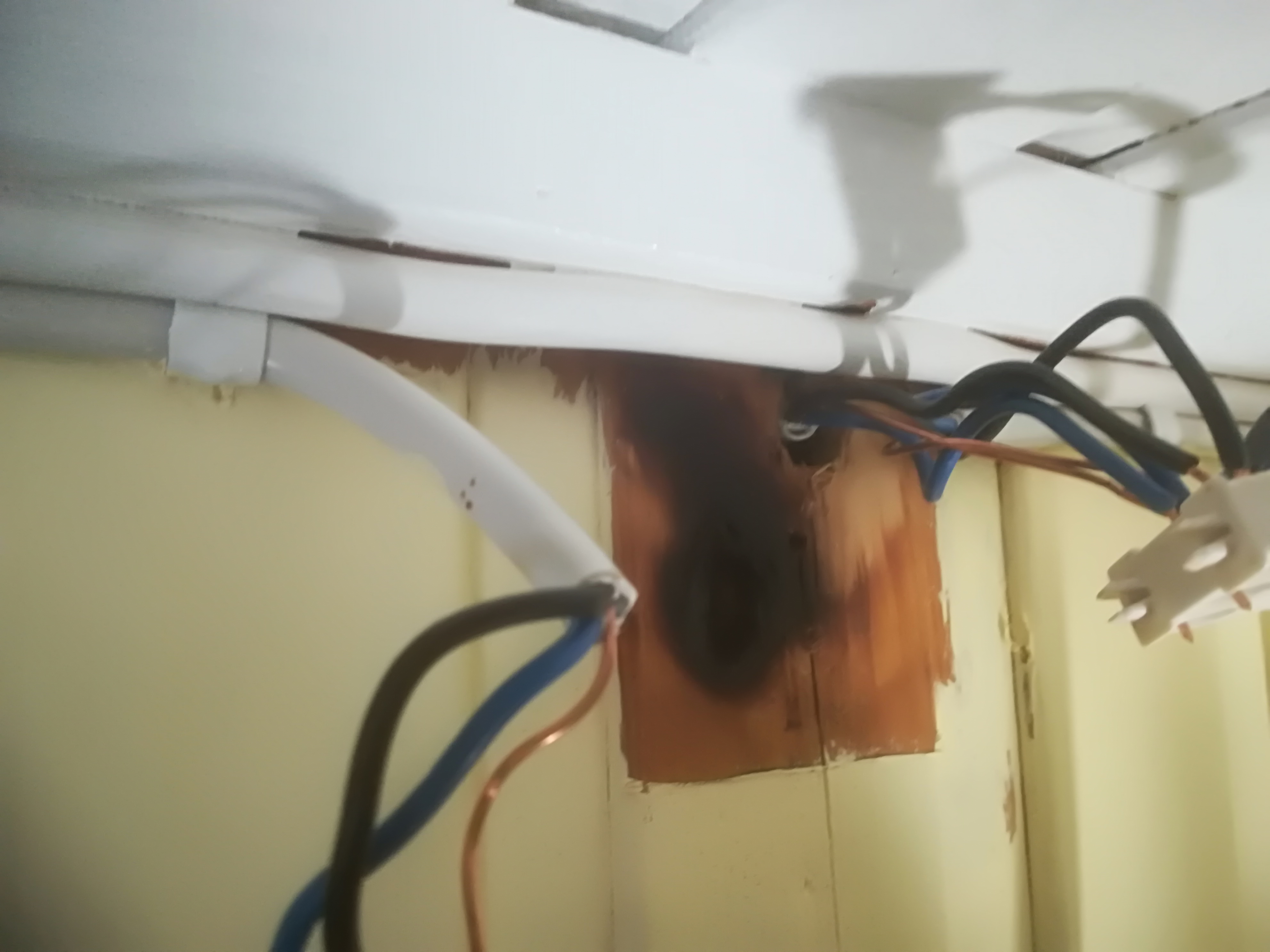I live in a country without residential building inspectors. Many people unfamiliar with Scandinavia will find that unbelievable. What happens, is that people with appropriate trade qualifications are allowed to police themselves, and private individuals are not permitted to undertake work covered by that protected trade. The challenge is that there is no independent third party who can inspect, and thereby determine if satisfactory work has been done or not. If there are flaws, home owners have five years to discover and voice complaints. After that, a statute of limitations sets in.
Incident #1
I invite you to look at the photograph below. It has been haunting me all day, bringing back memories of a situation that happened more than twenty-five years ago. The black charcoal is several millimeters thick. I estimate that if I had not discovered this smouldering fire when I did, disaster would have been only a few minutes away for a baby daughter, a young son and my wife and me. Confronting this fire was a pivotal moment in my life, and has shaped many of my attitudes.

Our house was wired indiscriminately with both aluminum and copper wires, undoubtedly by so-called professionals. In the junction box, both types of wire were joined together. One reason this could happen is that there were no electrical inspectors who could reject hazardous work like this. When I studied electricity and electronics in the mid-1960s, these dangers were already known, and we were informed in no uncertain terms never to mix them.
It was mainly in the period mid 1960s to mid 1970s that aluminum was used as an electrical conductor, mainly because it was relatively inexpensive but also because it was lighter, compared to copper wire. Unfortunately, aluminum deteriorates faster than copper, and develops more defects over time. However, the most important problems associated with mixing aluminum and copper wires is its electrical fire hazard.
Copper and aluminum can live harmoniously together, but they require special connectors to join them together. When two dissimilar metals meet they oxidize. Oxidation creates a connection with high levels of electrical resistance (lots of ohms, Ω) resulting in an unwanted voltage drop across the connection. This voltage drop can lead to three problems. First, low voltage can result in equipment failure. Second, energy can be wasted. Third, a connection can heat up and start fires.
Aluminum and copper do not expand and contract at the same rates as they heat up and cool down. This difference can cause connections to work loose, causing arcing (arc faults, arc flashes and electrical fires.)
Copper and aluminum wires can be spliced together using special copper-aluminum splices, that contain chemicals to prohibit oxidation. Unfortunately, many of these require special tools and expert knowledge.
Incident #2
Fast forward at least ten years to 2004. We decide to upgrade our fuse box to the latest in circuit breakers. We used the county-owned electrical company to do this work. At the time, the foreman who costed the job explained that we would not only be replacing fuses with circuit breakers, but the entire house would be re-balanced so that circuits that currently were overloaded, would have some of their work handled by circuits with available capacity.
This re-balancing never happened. We ended up with precisely the same circuits as before, admittedly with somewhat better circuit protection. Thus, the kitchen including all appliances with the exception of the stove, the living room and two bedrooms were on one 10 A circuit. In contrast, a second circuit serviced a single 60 W light bulb.
Talking about balancing circuits can be a great way to increase sales, but unless it is followed up, it can become just another empty promise. An electrical inspector can be a great aid at ensuring that circuits are not overloaded. The great advantage of an electrical inspector is that s/he is not overly burdened with worrying about work hours, but concerned with the quality and suitability of work actually performed. Since s/he is not selling his services, s/he is able to use her/his professional judgment and a standardized code to determine suitability.
Building Inspectors
There are several advantages with having building inspectors, including electrical inspectors. First, it would ensure that buildings are safe. This is the primary purpose of having building inspectors! Second, it would encourage ordinary people to build up their competence in construction related areas such as framing, plumbing and electricity. Young people, especially, could try out these areas to see if they are appealing for careers. Third, home owners would have assurance that tradespeople are using best practices, and that the work meets code requirements. Fourth, tradespeople would have a more level playing field, with all companies required to meet the same standards. There will be no incentives to take shortcuts. Fifth, companies will need to spend less time micro-managing employees. Building inspections are an easy way for employers to determine objectively, who is and who isn’t making mistakes on a construction site.
At the present time, the trades in Norway, experience an exodus of qualified practitioners, while some upgrade their competencies, many leave the trades entirely. Having building inspectors would be one way to ensure that tradespeople would be able to continue working in an area of competence, even after physical problems prevent them from doing the actual construction.
Building inspection could be a win-win-win-win-win situation for everyone involved in construction: house owners/ contractors/ tradespeople/ local authorities/ the community.
This weblog post was updated 2021/12/21. to eliminate Needs from the title. This post formed part of a Needs, Seeds and Weeds website that belonged to my daughter, Shelagh. In addition, other things are also out of date, or my opinions have changed. Apart from the title, updating the text to a block format and other minor formatting changes, the text above this paragraph remains as it was before. Any significant content changes are found below this paragraph.

